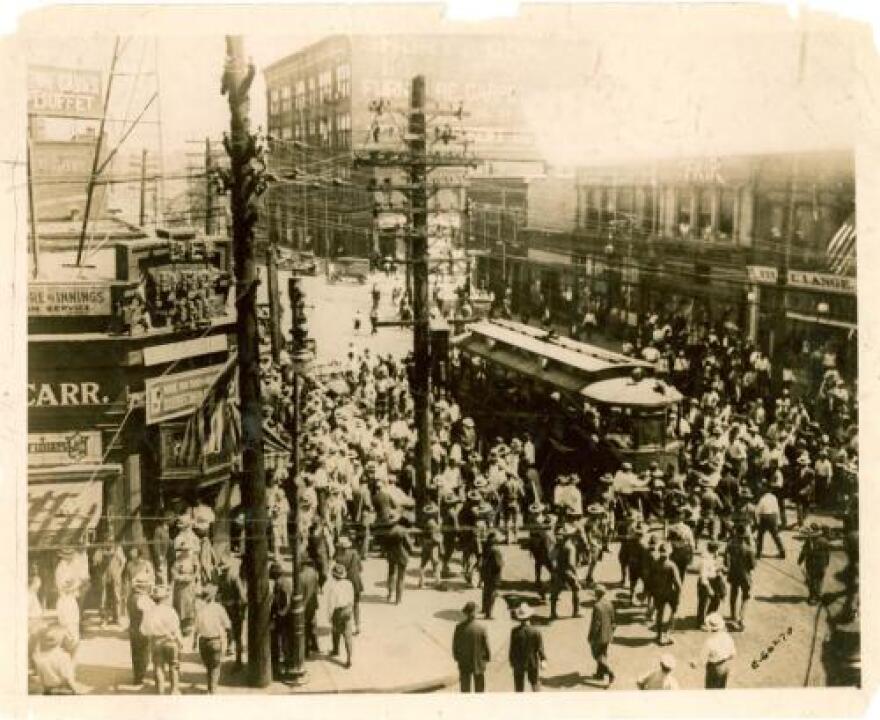The East St. Louis race riots have gone down in history as some of the worst examples of race relations in the St. Louis region. This Sunday, May 28, is the 100-year anniversary of the first, smaller riot. July 2 is the 100-year anniversary of one of the bloodiest race riots in the 1900s.
On Monday’s St. Louis on the Air, three guests joined Don Marsh to look back on the history of the riots and discuss how the centennial will be marked in the region.
Charles Lumpkins is the author of “American Pogrom” and professor of African and African American Studies at Pennsylvania State University. He said he prefers to refer to the violence as a pogrom (a word used in reference to violent attacks by local non-Jewish populations on Jews in the Russian Empire during the 19th and 20th centuries) because he believes the term ‘race riots’ has a distinctly different meaning in the early 1900s as opposed to the 1960s or even today.
In the early 1900s, the black population of East St. Louis was exploding even prior to The Great Migration, when hundreds of thousands of African-Americans left the south in search of work in more northerly cities. This caused a great deal of tension in the industrial town as the black population started to form its own political machine.
Andrew Theising, associate professor and chair of the department of political science at Southern Illinois University – Edwardsville, said that the events did not sneak up on anyone who was paying attention to the news in the region of that time.
“Everybody knew something big was coming,” Theising said. “Labor disputes had been going on. The newspaper headlines for the preceeding year had been inflammatory about ‘Negro colonization.’ It was conflated with public talk and rumors. Talk about fake news, there was quite a bit of it back then, and it stirred the wrong emotions.”
Things came to a head on May 28, 1917, when a first bout of violence occurred, although no one was killed and there was little property damage.
Lumpkins said that event stood in stark contrast to what happened on July 2, when at least 48 individuals were killed in the area, 29 of whom were black. Property damage was estimated into the millions and at least 7,000 black residents were permanently exiled from East St. Louis.
“The trigger incident was when a black neighborhood watch group was out patrolling their part of the neighborhood and they ran into an unmarked police car, bearing five policemen,” Lumpkins said. “People in that [defense] group thought [the people in the car] was another group of white drive-by shooters, which had been a problem in their neighborhood. The defense group shot and killed two of the plainclothes police detectives. That was the trigger incident that set off the fighting.”
The majority-white police officers were enraged and refused to protect black citizens as white citizens took out revenge. There were mass lynchings in the city and many people were burned alive. Most black East St. Louisans in and around the downtown area lost their residences and business properties in the fire.
“Legendary East St.Louisans” author Tiffany Lee said she has been disappointed to find the history of the riots in not taught in schools.
“It has not become a regular part of what we know about East St. Louis,” Lee said. “I did not learn about this until I was in college. We’re trying to rectify that, though, with an effort to educate the public, college students and younger students about what occurred.”
This coming weekend, an academic conference will kick off over a month of centennial events marking the riots. The conference will include a keynote address by Lumpkins as well as memory sharing and visioning events and a staged reading of “Tinderbox,” Gregory Carr’s play inspired by the events. A winner of a local student essay contest will also be announced on Friday.
“The East St. Louis Pogrom has so much to teach us, it is like a precursor to today’s developments and events and race relations in general,” Lumpkins said.
Related Events
What: East St. Louis 1917 Commemoration Kickoff Conference: "The City that Survives: Commemorating the Past, Preparing for the Future"
When: May 26 – 28, various times
Where: SIUE Higher Education Campus in East St. Louis, Building D Multipurpose Room, 601 James R. Thompson Blvd., East St. Louis
More information
What: Charles Lumpkins’ Keynote Address
When: 3 p.m., May 26
St. Louis on the Air brings you the stories of St. Louis and the people who live, work and create in our region. St. Louis on the Air host Don Marsh and producers Mary Edwards, Alex Heuer and Kelly Moffitt give you the information you need to make informed decisions and stay in touch with our diverse and vibrant St. Louis region.




